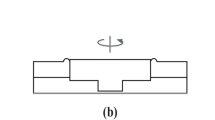Abstract
Friction-stir spot welding (FSSW) has been shown to be capable of joining advanced high-strength steel, with its flexibility in controlling the heat of welding and the resulting microstructure of the joint. This makes FSSW a potential alternative to resistance spot welding if tool life is sufficiently high, and if machine spindle loads are sufficiently low that the process can be implemented on an industrial robot. Robots for spot welding can typically sustain vertical loads of about 8 kN, but FSSW at tool speeds of less than 3000 rpm cause loads that are too high, in the range of 11–14 kN. Therefore, in the current work, tool speeds of 5000 rpm were employed to generate heat more quickly and to reduce welding loads to acceptable levels. Si3N4 tools were used for the welding experiments on 1.2-mm DP 980 steel. The FSSW process was modeled with a finite element approach using the Forge® software. An updated Lagrangian scheme with explicit time integration was employed to predict the flow of the sheet material, subjected to boundary conditions of a rotating tool and a fixed backing plate. Material flow was calculated from a velocity field that is two-dimensional, but heat generated by friction was computed by a novel approach, where the rotational velocity component imparted to the sheet by the tool surface was included in the thermal boundary conditions. An isotropic, viscoplastic Norton-Hoff law was used to compute the material flow stress as a function of strain, strain rate, and temperature. The model predicted welding temperatures to within 4%, and the position of the joint interface to within 10%, of the experimental results.







Similar content being viewed by others
References
V.H.L. Cortez, F.A.R. Valdes, and L.T. Trevino, Mater. Manuf. Process. 24, 1412 (2009).
M.I. Khan, M.L. Kuntz, P. Su, A. Gerlich, T. North, and Y. Zhou, Sci. Technol. Weld J. 12, 175 (2007).
M. Santella, Y. Hovanski, A. Frederick, G.J. Grant, and M.E. Dahl, Sci. Technol. Weld. J 15, 271 (2010).
M. Marya and X.Q. Gayden, Weld J. 84, 172s (2005).
M. Marya and X.Q. Gayden, Weld J. 84, 197s (2005).
Y. Hovanski, personal communication (2010).
C. Ma, S.D. Bhole, D.L. Chen, A. Lee, E. Biro, and G. Boudreau, Sci. Technol. Weld J. 11, 480 (2006).
F. Nikoosohbat, S. Kheirandish, M. Goodarzi, M. Pouranvari, and S.P.H. Marashi, Mater. Sci. Tech. Ser. 26, 738 (2010).
Y. Abe, T. Kato, and K. Mori, J. Mater. Process. Technol. 177, 417 (2006).
Y. Hovanski, M.L. Santella, and G.J. Grant, International Autobody Congress (MI: Troy, 2009).
Y. Hovanski, M.L. Santella, and G.J. Grant, Scripta Mater. 57, 873 (2007).
Y.D. Chung, H. Fujii, R. Ueji, and N. Tsuji, Scripta Mater. 63, 223 (2010).
Y.D. Chung, H. Fujii, R. Ueji, and K. Nogi, Sci. Technol. Weld. J. 14, 233 (2009).
Y.S. Sato, H. Yamanoi, H. Kokawa, and T. Furuhara, ISIJ Int. 48, 71 (2008).
Y.S. Sato, H. Yamanoi, H. Kokawa, and T. Furuhara, Scripta Mater. 57, 557 (2007).
Y.S. Sato, N. Harayama, H. Kokawa, H. Inoue, Y. Tadokoro, and S. Tsuge, Sci. Technol. Weld. J. 14, 202 (2009).
A.P. Reynolds, W. Tang, M. Posada, and J. Deloach, Sci. Technol. Weld. J. 8, 455 (2003).
M.P. Miles, J. Pew, T.W. Nelson, and M. Li, Sci. Technol. Weld. J. 11, 384 (2006).
M.P. Miles, T.W. Nelson, R. Steel, E. Olsen, and M. Gallagher, Sci. Technol. Weld. J. 14, 228 (2009).
M.P. Miles, C. Ridges, Y. Hovanski, J. Peterson, M.L. Santella, and R. Steel, Sci. Technol. Weld. J. 16, 642 (2011).
S. Mandal, J. Rice, and A.A. Elmustafa, J. Mater. Process. Tech. 203, 411 (2008).
M. Awang and V.H. Mucino, Mater. Manuf. Process. 25, 167 (2010).
S.A. Transvalor, Forge 2009 (2009).
JMatPro, Sente Software Ltd. (Surrey Technology Centre, Guildford, 2014).
M. Miles, T. Nelson, L. Fourment, and S. Guerdoux, “Steady-State Simulation of Material Flow and Temperature in Friction Stir Welding of Aluminum Alloy 6061” (paper presented at Materials Science & Technology 2008 - Joining of Advances and Specialty Metals; Pittsburgh, PA, 2008).
N. Saunders, M. Miles, T. Hartman, Y. Hovanski, T.-T. Hong, and Russell Steel, Int. J. Precis. Eng. Manufact. 15, 8 (2014).
Acknowledgements
This work was supported by National Science Foundation grant CMMI-1131203 and by funding from the Department of Energy, EERE-Vehicle Technologies Office, via PNNL subcontract 116126.
Author information
Authors and Affiliations
Corresponding author
Rights and permissions
About this article
Cite this article
Miles, M., Karki, U. & Hovanski, Y. Temperature and Material Flow Prediction in Friction-Stir Spot Welding of Advanced High-Strength Steel. JOM 66, 2130–2136 (2014). https://doi.org/10.1007/s11837-014-1125-6
Received:
Accepted:
Published:
Issue Date:
DOI: https://doi.org/10.1007/s11837-014-1125-6




